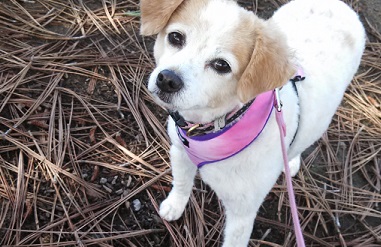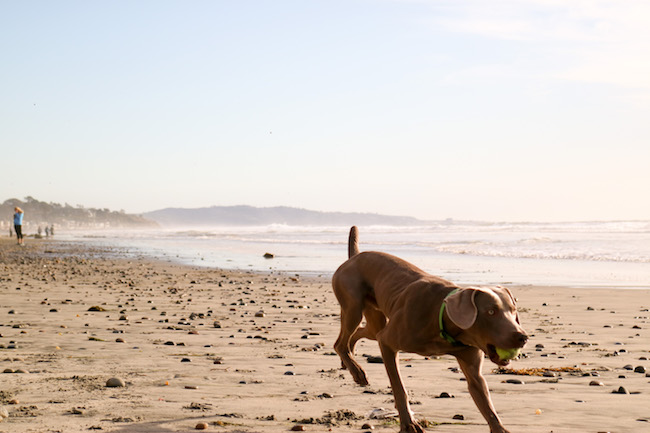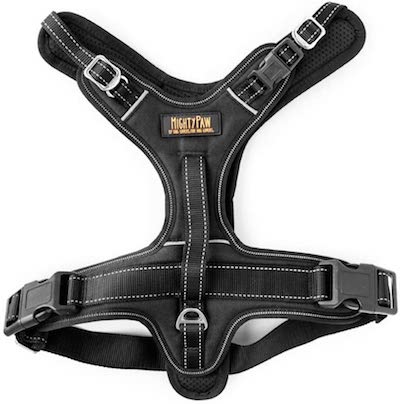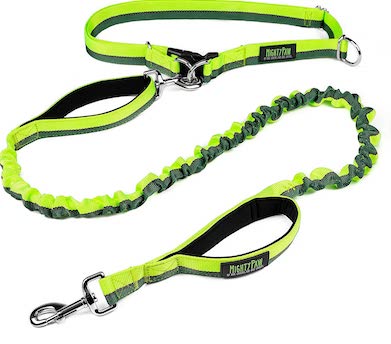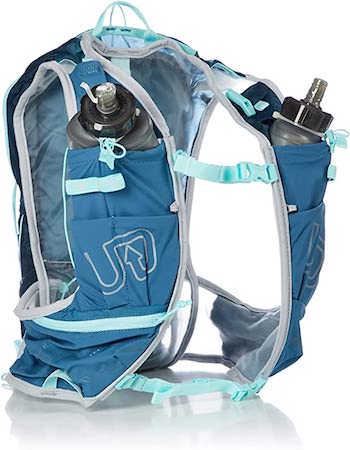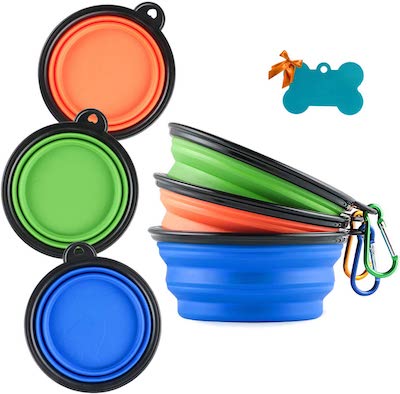
Table of Contents
Tips for running with your dog
I get a lot of questions about running with your dog, so today I’m going to answer the most frequent questions.
I’ve been running with dogs for over 20 years, including the thousands of miles I logged through my dog running and walking business. I’ve been lucky to run as a volunteer with various shelter dogs and I run with my own dog, a 5-year-old weimaraner named Remy.
How to run with a dog
If your dog is at least a year old and healthy, you can most likely ease into running right away. Ideally, your dog should be used to going on some long walks and being on a leash. So maybe you’re already able to walk for 45 to 60 minutes a day before you introduce running.
Obviously you don’t want to start out by heading out for a 5K race on your very first run with your dog!
Start with just a half-mile during one of your normal walks. That will likely go fine, so the next day, try 1 mile.
I recommend you run just 2-3 times a week at first and no more than 2-3 miles at a time, depending on the dog. Some are born to run and will have no issues but always lean on the side of caution when you’re just starting out.
The most common injury I see with dogs just starting out in running is they tend to wear their paw pads down if they are not used to running on pavement.
So, stop and check the bottom of your dog’s feet after a few minutes. If they appear scuffed or tender, you’ll need to ease into running even more gradually to allow your dog’s paw pads time to callous.
When in doubt about running with a dog, whether it’s due to their age, their breed or their size, it’s always a good idea to make a quick phone call to the vet.
How far can I run with my dog?
That is a tough question because there is a HUGE range of dogs out there. Different sizes, breeds, coat types, energy levels, different ages.
I did run with hundreds of different dogs through my business and almost all dogs could easily handle a nice, easy 3-mile run.
They key is just to start slowly and very gradually build up their distance.
Start with just a half-mile. Then increase the distance to 1, 2 and then 3 miles slowly over about a month. Once your dog is able to run 3 miles a few times per week with no problems, then you could try adding in a longer run of 4 or 5 miles. If that goes well, slowly increase again in a few weeks.
A lot of dogs of all breeds and sizes can easily handle a nice, steady 5-mile run once or twice a week.
Others can handle 10+ miles easily. Think dogs meant for hunting or endurance. Breeds like pointers, huskies, vizslas and weimaraners.
Can I run with my small dog?
Yes!
Some small dogs will have more energy and endurance than others, but most can run with you for at least 1-2 miles.
Start with 1 mile for a few runs, and increase the distance if your dog seems OK.
Jack Russell terriers are a good example of a small breed that can easily run 5 miles or more. Many of the terrier breeds make good runners. Other smaller dogs that often enjoy running include beagles, miniature poodles and papillons.
How old does my puppy need to be to start running?
No matter who you ask, you will get a different answer, even among veterinarians.
There are also a lot of differences among breeds. Smaller and medium dogs tend to physically mature faster than the larger breeds.
If you want to be on the safe side and go with the most common recommendation, you should start running with your pup once he turns around 12 months old. Wait a bit longer if you’re worried about it. Jump in a little sooner if you feel it is right for your specific dog.
Puppy growth plates and running
The reason to hold off on running with a puppy is to allow the puppy’s growth plates to close. However, there is no scientific evidence that says running is harmful to a puppy. Most vets and breeders will lean on the side of caution and tell their clients to wait until the puppy is least 8 months old or so. Some will say to wait 12 to 18 months.
So … you will have to make a judgement call here.
I personally started running with my weim when he was 6 months old, but we only did a half-mile a few times a week. I gradually increased his running distance so when he was 8-9 months old we were running 2-3 miles a few times per week in addition to a lot of walking. When he turned a year old, I started taking him on my 5-mile long runs every Saturday.
Keep in mind that when a dog “runs” with a person, the dog is usually just walking fast while the person is running. Our pace is painfully slow to most dogs!
That being said, I do not recommend rollerblading or biking with puppies or long distance running. Wait until they are at least 12 months old for that kind of hard pounding.
When unsure, it’s always best to ask a vet. And don’t hesitate to get a second opinion.
How do I stop my dog from pulling while running?
This can be one of the most frustrating issues to deal with!
The first thing you need to do is think about and define your “rules.”
For example, decide if you want to allow your dog to pull while running. There is no right or wrong answer. It depends on personal preference, safety and the specific dog.
Some people choose to allow their dogs to run in front, pulling. Others allow the dog to be in front as long as they are not pulling.
Or, you might want to train your dog to run at your side without pulling, period.
The second question to ask yourself is do you want to have the same rules for walking vs. running?
It’s OK have separate rules for running vs. walking. You just need to define these rules for yourself so you can be consistent in training your dog.
Most people are not consistent. And then they get frustrated with the dog!
Different gear for running vs. walking
Dogs can learn that different gear means different things. I find this especially helpful because I personally allow my dog to pull me while running but sometimes I want him to “heel” at my side during walks.
So, when my dog wears a harness, he knows he can pull.
When the leash is attached to his collar and I say “heel,” he is expected to walk at my left side without pulling.
This takes a lot of time and consistency!
How to train a dog not to pull on the leash
This takes a lot of time and patience so do not expect your dog to figure this out overnight or even in a few weeks. It’s an ongoing training process.
The main thing is to be consistent. If the dog pulls, you need to stop moving. You can lure him back with a treat or give a quick tug on the leash and turn the other way. Or just stand still and wait him out (might take a minute, that’s fine).
Praise him when the leash is loose again or if he turns towards you. Reward him by moving forward again.
I also highly, highly recommend you sign up for a basic obedience class or hire a trainer to help you one-on-one.
Beyond that, I find it so helpful to just have a harness I can slap on my dog and allow him to pull in the harness. I personally don’t have the time or patience to always be working on training.
My dog is extremely high energy. Like, off the charts. And sometimes we just need to go out for a fun walk or run without worrying about the pulling.
When we work on training, my dog wears a collar, not a harness.
But, you don’t have to do what I do. Just be consistent and come up with a long-term plan that works for you and your specific dog.
What gear does my dog need for running?
All you really need to get started is a collar and a leash!
But, you’ll probably find you prefer certain gear to help manage your specific dog or to make running more comfortable for you both.
Harness and leash
I recommend a good harness for running with your dog. We have a specific canicross harness but we also use our Mighty Paw sport harness for every day running. A harness removes any pressure from my dog’s neck and throat while running.
Any leash is fine, but I personally don’t use a standard nylon leash because it’s too difficult to grip.
I like to use a leather leash because it’s easier to grip and gives me more control.
You could also try a bungee leash because it has more “give” when the dog pulls. But, you’ll want one with an extra handle so you still have control.
Hands-free leash
If you want to try a hands-free leash, get one that has a bungee leash such as Mighty Paw’s.
A way to carry water & poop bags
For longer runs or runs in the heat, I wear an Ultimate Direction running vest so I can easily carry water bottles for myself and my dog.
I bring a small collapsible water bowl for my dog.
Most of these bowls are 3 cups but I prefer the smaller 1.5 cup option because it fits easier in my pack.
Common injuries to dogs while running
For dogs that aren’t used to being walked on pavement, stop and check their paw pads every 15 minutes or so. Dogs that are walked often will develop calloused feet – and that’s a good thing.
If dogs are kept indoors or in the grass all the time, their paws won’t be able to handle a lot of running right away. You’ll have to slowly increase the distance. It would be the equivalent of you going for a run in the street without shoes.
Also watch for any limping or stiffness the day after a run. If the dog is not used to running, she could pull a muscle or feel sore the next day.
Overweight dogs shouldn’t run because their extra body weight will put too much stress on their joints. Stick to walking until the dog loses some weight.
Dogs with “short faces” like English bulldogs and Boston terriers can overheat very easily. Running is still great exercise for them, but be very careful on hot days.
Giant-breed dogs like English mastiffs and Newfoundlands are generally lower energy and do not do very well with running. A lot of veterinarians recommend that giant breed dogs stick to walking because it’s easier on their joints. This is good advice in general, but every dog is different.
How much do I feed my dog if he runs with me?
You don’t need to overthink this. Yes, your dog might need slightly more calories if you’re adding more activity than normal. But most people still tend to overfeed their dogs.
Measure your dog’s food for each meal and feed him regularly scheduled meals so you know exactly how much your dog eats per day. Do not “free feed” your dog.
If your dog looks a little lean, then feed him more. If he looks a little chubby, then feed him less. If you are increasing your dog’s exercise, then it makes sense that he will require a little more food in order to maintain his healthy weight.
When is it too hot to run with a dog?
Usually it’s too hot to run a dog during the middle of the day in the summer. Black dogs, overweight dogs, short-faced dogs and extra hairy dogs get overheated too easily. And some dogs with shorter coats like my weimaraner get sunburned more easily.
I don’t recommend running with any sort of training tool that fits over the dog’s face such as a Gentle Leader or Halti unless you are VERY careful and certain your dog is panting properly. Dogs can still pant while wearing these, but some won’t be able to pant as heavily as they need to on a hot day.
Bring water along during your summer runs or plan your route so you can loop back home for a quick drink.
Keep a close eye on your dog and take it easy if he starts to pant heavily, slow down or drag behind. Take breaks often and sit in the shade. Signs of heatstroke (hyperthermia) in dogs include rapid panting, dizziness, diarrhea, pale gums and a long, red tongue.
If your dog gets too hot, help him cool down slowly by offering him some water and a chance to rest in a cool, indoor area. Place cool, damp towels under his belly and paws.
Remember, some dogs (like mine) do not have an “off switch” during certain activities such as rollerblading or chasing a ball. It’s up to us to make them take breaks every 15 minutes to avoid overheating.
How can I tell if my dog is too tired during a run?
If she is dragging behind you or panting heavily. If that’s the case, slow down to a walk. Bring water along on hot days.
When is it too cold to run with a dog?
As long as you keep moving, most dogs can go for a 20-minute run or longer no matter how cold it gets.
I lived in North Dakota where the winter temperature is very often 10 below zero or colder. And that’s not counting the windchill.
The dogs were typically just fine for a half-hour run without any kind of dog coat as long as we kept moving at a quick pace. Even the short haired breeds without undercoats (like vizslas) were fine in January for up to 30 minutes.
Dogs have fur coats and they can handle the cold better than us. If you are cold, then head inside. If you are fine, your dog is probably fine.
Obviously you want to take extra precautions on cold days by running closer to home and putting a coat on your dog if he needs one. I tend to run shorter loops around the neighborhood on colder days vs. heading out on long out and back routes. That way, if my dog gets too cold, we can always get inside.
And by all means, if your dog is shivering and lifting up her paws for more than a few minutes, bring her inside!
What is the best coat for a dog?
Most dogs don’t need a coat.
If your dog seems cold outside, then shop for a dog coat at a sporting goods store that carries hunting gear for dogs. Or look at brands that are designed for active dogs such as Ruffwear or Kurgo.
I like the Ruffwear Powder Hound jacket for my weimaraner who has very short fur and very little body fat. It seems fairly warm and he’s still able to move easily while wearing it.
For serious protection against the cold, get your dog a waterproof vest designed for hunting Labs. I’ve used the Avery vest for my dogs and it’s lasted over 12 years!
Unfortunately if you have a small dog, you probably won’t be able to find a hunting vest for him. I wouldn’t worry too much. Dogs have their own natural fur coats. They don’t really need more than that.
What dog boots do you recommend for winter?
Most dogs probably won’t need boots to keep their paws warm. However, if your dog is lifting up her feet in obvious discomfort or if she keeps getting snow between her toes, the brand that works the best for my dog is Muttluks because they velcro on tight but they are lightweight. I use the original fleece lined Muttluks.
Keep in mind you need to slowly introduce these to your dog in a positive way. Don’t just slap four boots on him and expect to head out for a run. Introduce just one at a time, slowly, over a few days in the house before you try to head outside in them.
I do recommend dog boots for protection against de-icing chemicals or sharp/jagged ice. Dog boots can also prevent ice and snow from building up between the toes of a longhaired dog.
If you want something really lightweight that most dogs will tolerate, look into the disposable Pawz boots. You throw these away after using them a few times but they are so light weight that most dogs will tolerate them. Don’t use them for warmth though, just for protection against chemicals or snow buildup between the toes.
What other questions do you have about running with a dog?
Let me know in the comments!
-Lindsay



